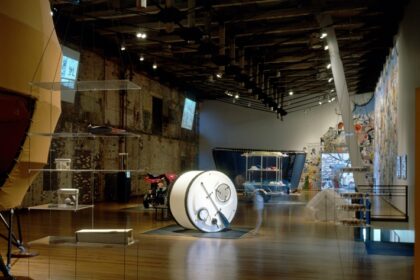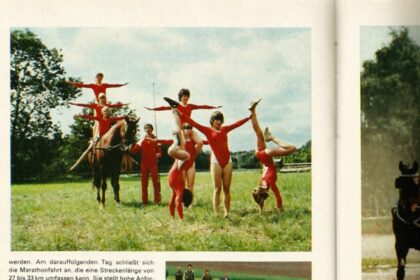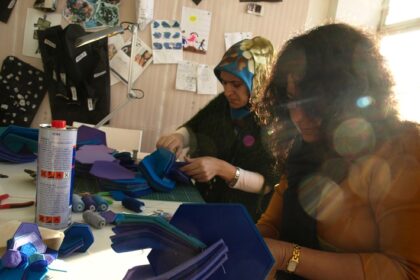An Interview with Althea Thauberger
Noni Brynjolson
In 2005, Canadian artist Althea Thauberger was invited to make a public artwork for inSite, a biennial of collaborative and site-specific work that took place across the San Diego-Tijuana border region. The work she made was Murphy Canyon Choir, which involved collaborating with spouses of active-duty soldiers at one of the largest military housing complexes in the world. Thauberger often works with insular communities whose experiences reflect issues of broad societal importance, including teenage songwriters, tree planters and female soldiers in Afghanistan. Reflecting on Murphy Canyon Choir, Althea spoke to me about the site of the work, its emotional and affective qualities, and its public performance, which she views as having opened a space for dialogue between two disparate communities.
NB: I’m curious to hear about your first impressions of San Diego. Maybe you could begin by speaking about your sense of the city, and describe the research process that led to Murphy Canyon Choir.
AT: I was invited to come to San Diego by the inSite curatorial group, after they visited Vancouver and met with me and other artists there. My first visit to San Diego included a tour of the region facilitated by inSite curators, where we also met with local artists, architects and urban theorists. Over the next year I was there for a week or two at a time, and then longer visits and trips leading up to the actual event. My first impressions were centered around these tours, which focused mainly on the border region. I was struck with San Diego as being quite alienating and very spread out, and I remember saying at that time that I thought of it as being the epicenter of everything that must fail: extreme car culture, extreme militarism, and this very corporate atmosphere – the city seemed to lack the kind of broader planning that makes a place reasonable and livable. Because of the way the city was planned, you have all of these residential developments that are right next to each other geographically, but are disconnected socially and economically. Also, it was interesting to me to see the amount of undeveloped land around the city. There are these vast areas of desert preserved in their natural state, which you quickly realize are military reserve lands. It was so striking, the amount of area that was not developed, it had a very iconic appearance that signified the importance of San Diego as a strategic military site.
NB: I think it’s interesting that you didn’t arrive in San Diego with a specific project in mind, which is the case with so many artists who make public art in a biennial or festival context. Instead, the project you developed was a response to the site, to the city, even to the landscape, and came out of experiencing a space and learning about the social relationships that shape that space. How did you initially get involved with military organizations in the city?
AT: Yes, and this was largely due to the way inSite structured our visits, which was quite generous. I started to speak with the curators and others about the military population in San Diego and I could see that there was a real disconnect. It’s such a massive percentage of the city and it seemed strange to me that it wasn’t of interest or importance to most people. It just seemed to be kind of an invisible group in the city. I started to meet people who were generous enough to come to the inSite office or allow me to come to their office and speak with them. The USO (United Service Organizations) was first. It’s an organization that supports military families at home, especially families who have a deployed spouse. I went there, met with the director and started to get statistics: how many families were there, what is their social and economic situation, where do they live, what is their life like? I realized that entry level military families were living in poverty and some were even living in Tijuana and commuting because they couldn’t afford to live in San Diego. A lot of the people I met were in the military because they had a child with a medical condition, and it was the only way they could afford health care. I started volunteering at the USO and also visited the armed services YMCA near Murphy Canyon, which had after school programs for kids and activity groups for moms who were on their own because of deployment. So I started to attend all of these activity and support groups and I would explain, I’m here from Canada and I’m doing a project that involves the military, but I’m just trying to learn as much as I can right now.
NB: How did the idea of forming a choir come up? Was it something that you proposed, or was it suggested by someone you met while volunteering?
AT: There were a few ideas that I was floating around and testing out when I met with people, which involved theater and music, and the idea of forming a choir or musical group always got the best reception. People thought it would be filling in a kind of gap, and a choir would involve people coming together and working on a common goal. I also saw the potential for it to be an outlet for some form of resistance. We spoke about participation for military spouses, women and men, but it turned out that it was only women who were interested, and of course women are the vast majority of spouses in the military. There were eight participants in the end, more in the beginning, but many people lost interest when they realized how much of a commitment it would be, and I have to admit that most of the final participants were able to make the commitment because they were not in a position of complete struggle, meaning they had some external family or friendship relationships who could support their involvement. Our largest expense by far was childcare, we had to find certified childcare for all of the times when they were in rehearsals or meetings.
NB: What kinds of songs did they write?
AT: Part of the mandate of the choir was that they were going to perform original material, which meant that they had to learn how to write music. The idea was that this would be an opportunity to engage in a creative process, have discussions and debates and make decisions together as a group regarding content. I think it’s important that when you’re working with people and asking them to make a commitment to something, it has to be fulfilling on their terms, but also challenging. I also think it’s important to encourage people to go outside their comfort zones and learn something new about themselves. I include myself as director and also contemporary art audiences in this. The women wrote the songs with a choral composer, Scott Wallingford, who came from a contemporary music background, and their musical interests were pop and country, so it was interesting to see this fusion of interests and the negotiations that took place. He worked with them very intensely for months on these compositions. I was sort of surprised, because I had many conversations with these women and I knew that they were not particularly interested in a stereotypical way of expressing themselves, but most of the songs they wrote turned out to be on the clichéd side. For example, one was titled “Wife of a Hero.” I realized afterwards though, that of course they see this as a role they are supposed to play. They’ve already put themselves out of their comfort zone in terms of performing, learning to sing, learning to write music, they’re not going to go so far that they’re actually also challenging the dominant narrative of the military spouse. So of course that made sense afterwards, looking back on the project.
NB: Can you describe the final performance?
AT: It took place in a school auditorium in Murphy Canyon. There were two groups, one was friends and family who were locals of Murphy Canyon, and the other half was the inSite crowd who were coming from the Museum of Contemporary Art San Diego. It was one of the weekends when there were many projects going on around San Diego and Tijuana, and they had a bus that would depart from the museum and take audiences to these different locations. At the time I was thinking a lot about the experience of getting picked up on a tour bus at the museum, and getting dropped off at a destination to see a contemporary artwork – it was an extremely problematic and voyeuristic setup that I felt the need to confront. I invited a very articulate young woman from Murphy Canyon to be a tour guide on the bus. Her husband was deployed and she had three children, and she was working for a religious organization that collected and delivered food baskets to other military families.
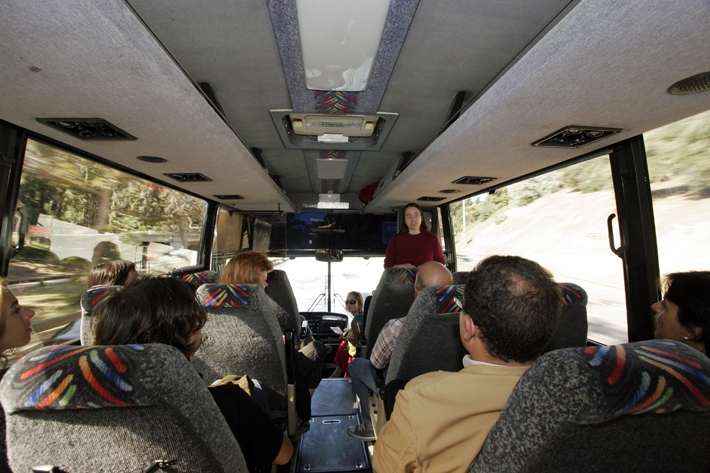
She stood at the front of the bus and answered questions. You have to remember that this was in 2005, when tensions around the Iraq War and American foreign policy were running high. So at first, the questions were rather hostile, like “what is your position on George W. Bush’s illegal war on terror?” And of course she’s not in a position to make a public statement on that. But then the questions started changing to, “What is it like to be you? Do you have guns in your house? When is he coming home?” So that was the first experience that the art audience had. Then they got off the bus and entered the auditorium and the audiences began to mix, you had a military family sitting next to a curator, sitting next to an artist. All of the performers were wearing lavalier microphones, so their voices were picked up in very close proximity and there was an intimacy to the sound. They sat in the last row of seats in the audience for the first song, behind everyone, then performed a second song from the sides of the room, singing to each other, and then finally for the third song they got onto the stage and performed the rest of the songs on the stage. Their singing was at times spot on and amazing and at other times kind of fell apart. It was their first performance so at times they kind of lost it, and then they would come together again, and this added to the feeling of anticipation and empathy somehow, of everyone coming together and really wanting it to work out.
NB: The performance happened in front of a diverse audience that included artists, curators and other cultural workers associated with inSite, as well as military families and local residents. What was it like seeing these different groups interact, and do you think they had different responses or reactions to the performance?
AT: I knew the songs and had been working a lot with the women in rehearsals, but I didn’t know how art audiences were going to react. Were they going to find it pathetic, stereotypical, moving, uninteresting? I really didn’t know, and it’s really terrifying to bring these different groups of people together and ask these young women to put themselves in this situation where they’re vulnerable, especially knowing that contemporary art audiences can be quite critical. But in fact, the response was very emotional. People were weeping during songs. Curators! I never would have thought. You could hear each of the individual singers’ voices quite clearly, as opposed to the typical choral experience where voices blend together. In the performance they were individuals singing together, and it was very moving. Directly after the performance, a BBQ picnic was organized by inSite and myself, so everyone stayed and had some food, and people had a chance to meet and mix and talk about the performance.
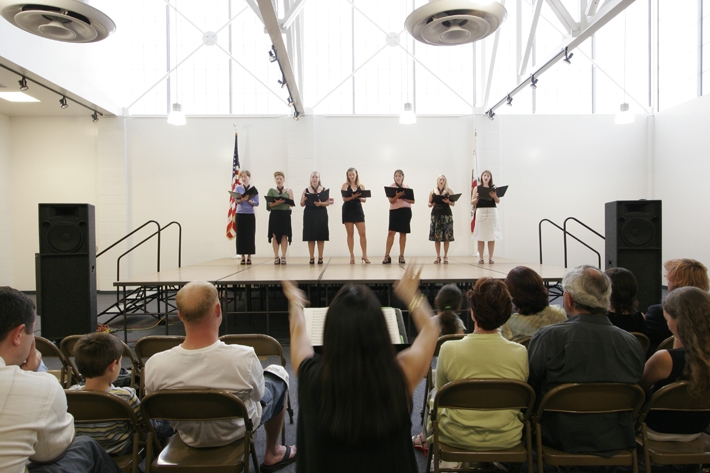
NB: In retrospect, what do you think the impact of this project was? What did the participants get out of the experience?
AT: The question of impact is an important one, but I also take issue with it, in a way. In this case, as military spouses, the participants in the project have a rather nomadic life and they all have almost certainly moved several times since 2005 so I don’t know if they continue to be in touch. For myself as director/instigator, I think it’s very important to understand and be aware of the perspective of the participants you’re working with, and for a project like this to be challenging, rewarding, and transformative on their terms, not just on your terms. But I also disagree with this notion of follow up and long term results of a project in some cases. I think that a work can be transformative at that moment and for the period of time of that event, not about a radical or long-term change in my life or your life. Some projects, like this one are about a moment of togetherness and happen in a very particular moment, and because of that it can potentially change our way of thinking in some small way. It was not the goal of the project to make life better – the goal was to make a really great work of art and to enable discussion. That it has an impact on the world and people’s thinking is part of it, but I don’t think of it as akin to community art which uses art primarily as a tool to effect a certain change that we wish to see in participants or the world, and not so much as a work that can also stand on its own. I think that there is something of this kind of tension in this impulse and desire to do all this follow up, wanting to see someone’s life change for having participated in something, and frankly that’s probably not the case with this work.
NB: Do you see any relationship between your work and the historic avant-garde? Do you see it as questioning aesthetic boundaries, or testing out new strategies of collaboration or engagement?
AT: These are hard questions to answer as an artist. Of course I hope that my work does these things, but I’m not the person to map that out. Not speaking specifically about my work but speaking specifically about these ideas, I think the notion of the avant-garde is really problematic and defunct and is one that has been the paradigm of the twentieth century and has failed us miserably politically. But it’s the paradigm we have, we haven’t replaced it with anything yet. So it’s one that is deeply fraught and problematic, but it’s the one that we have. I also think it’s critical that we don’t continue to make work that only functions as an insider conversation, for a group of insiders. It can be that, but it must circulate among wider audiences, this is crucial for me.
NB: Many artists who create images of war or the military take an overtly critical stance. Your work is more ideologically ambiguous, since you have had to adopt a certain amount of complicity with institutions of warfare in order to build relationships with individuals and communities. How do you think your work then engages with, or resists, the practice of institutional critique? And do you see your role as an artist as involving criticality or oppositionality?
AT: With regards to the military I don’t see the work I’ve made as being easily taken up and used for their own purposes. In fact, I see it as being quite difficult to do that with. I see it as my job to make work that doesn’t neatly fit into a specific category or context, and that includes when it’s published in a military magazine and when it’s shown in a contemporary art gallery. Obviously, as you say, there is a degree of complicity involved with my work, since I had to gain access somehow. I think my work absolutely comes through institutional critique, but I think that any artist who comes through the western canon who meaningfully thinks about their practice has to come through that. For me it’s not just about the military, a huge institution that is very powerful and would be very easy to have your work subsumed by, but also facilitating art organizations who might have a history of deploying art in particular ways. For example, inSite is an institution as well and I would have a critical viewpoint about it even though I think their work has been very important. But any time I have an opportunity to make work, visit a place, work on a commission, there is some kind of organization or institution, and an imperative behind that invitation. Where is that money coming from? How do they see the value of an artwork that is going to emerge from that funding, and what is my relationship with that? It’s always about looking at myself and who I’m working with, whether it’s a gallery, funding body, psychiatric hospital or school. And in terms of criticality, I think that at this moment a lot of discussion in the art world relies on very pat notions of what it means to be critical. They’re notions that we get really quickly and they’re often not useful anymore. It’s just an inside conversation, it’s not upsetting or changing anything. As I see it, the only way to change this is to make work that is compelling enough for people to meaningfully want to engage with. And then to both deploy and upset the existing formulas of things like institutional critique.
Althea Thauberger is an artist based in Vancouver, Canada. Her internationally produced and exhibited work typically involves interactions with a group or community that result in performances, films, videos, audio recordings, and books. Her work has been presented at the 17th Biennale of Sydney; National Gallery of Canada, Ottawa; The Andy Warhol Museum, Pittsburgh; Guangzhou Triennial; Manifesta 7, Trento; Morris and Helen Belkin Art Gallery, Vancouver; Vancouver Art Gallery; BAK, Utrecht; Künstlerhaus Bethanien, Berlin; Kunstverein Wolfsburg; Art Gallery of Nova Scotia, Halifax; Singapore History Museum; Presentation House Gallery, Vancouver; Museum van Hedendaagse Kunst, Antwerp; Berkeley Art Museum; Insite, San Diego/Tijuana; White Columns, New York; and Seattle Art Museum.
Noni Brynjolson is a PhD student in Art History, Theory and Criticism at the University of California, San Diego.







